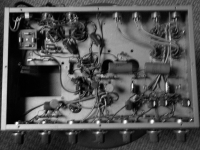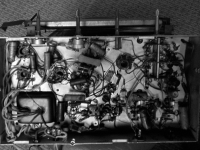Not sure if this thread has a previous life or not. My intent here is to consolidate experience and knowledge in the area of constructing point to point circuits like the "Old Masters" did.
Exhibit 'A' and 'B' for discussion. 'A'- McGOHAN ELECTRONICS 35 Watt PA; 'B'- An old multiband radio circa 40's, not sure on actual date.
Why, under the circumstances, particularly in the case of the multiband Radio, 'B', did these devices work, in the context of all the layout problem talk I see on amp construction boards?
I've begun to move in this direction and first find: Some planning is in order as you can end up trying to make a connection that belongs on a bottom layer after layers 2 and 3 have already been set down.
Since I'm at the novice stage for this, any suggestions or ideas from experienced members would be appreciated. Is this even a good idea or was P2P abandoned in favour of structured layout methods?
To what extent can this be used? Before you say it won't work on High Gain builds I think we need to look at some old High Tech instrumentation images from the web- Suggested images?
Keep in mind also the RF stages associated with 'B' images. RF is more likely to couple then audio frequencies I would think- ?
Regards,
Ccat.
Exhibit 'A' and 'B' for discussion. 'A'- McGOHAN ELECTRONICS 35 Watt PA; 'B'- An old multiband radio circa 40's, not sure on actual date.
Why, under the circumstances, particularly in the case of the multiband Radio, 'B', did these devices work, in the context of all the layout problem talk I see on amp construction boards?
I've begun to move in this direction and first find: Some planning is in order as you can end up trying to make a connection that belongs on a bottom layer after layers 2 and 3 have already been set down.
Since I'm at the novice stage for this, any suggestions or ideas from experienced members would be appreciated. Is this even a good idea or was P2P abandoned in favour of structured layout methods?
To what extent can this be used? Before you say it won't work on High Gain builds I think we need to look at some old High Tech instrumentation images from the web- Suggested images?
Keep in mind also the RF stages associated with 'B' images. RF is more likely to couple then audio frequencies I would think- ?
Regards,
Ccat.
Attachments
there were thousands and thousands of circuits built point to point that worked, including early radar.
I have a compact Heathkit scope I made point to point around 1970. I would like to refurb it but the wiring inside is a nightmare.
If you only want to acheive 40-60 db signal to noise and mono, you can get away with a lot.
circuit boards cut labour costs and increase repeatable results.
In the 70's I made a pc? intel 8008 250khz clock and a lot was point to point with perf boards. I wouldn't want to do it now with modern processors and nearly microscopic parts.
I have a compact Heathkit scope I made point to point around 1970. I would like to refurb it but the wiring inside is a nightmare.
If you only want to acheive 40-60 db signal to noise and mono, you can get away with a lot.
circuit boards cut labour costs and increase repeatable results.
In the 70's I made a pc? intel 8008 250khz clock and a lot was point to point with perf boards. I wouldn't want to do it now with modern processors and nearly microscopic parts.
IMSI
Perhaps then you remember the IMSI. A coworker built one where I was employed. I tell my wife to grab one if she ever see's something like that at a garage sale. They should start appearing soon.
I started in the computer industry in 78. By then PC boards were in use but there were wire wraps too on the backplane. Huge linear PS and a cartridge HDA of 5 MB. System ram was 8k and code was compact machine code many times.
Hmm... Wire wrap carrying 5 mhz, (what was the z80 clock?)...
I don't know how to gauge 40 - 60 db signal to noise. What sort of amp comparison would be equivalent? A Bassman but not a Mesa?
Thanks for the trip down memory lane,
Ccat.
Perhaps then you remember the IMSI. A coworker built one where I was employed. I tell my wife to grab one if she ever see's something like that at a garage sale. They should start appearing soon.
I started in the computer industry in 78. By then PC boards were in use but there were wire wraps too on the backplane. Huge linear PS and a cartridge HDA of 5 MB. System ram was 8k and code was compact machine code many times.
Hmm... Wire wrap carrying 5 mhz, (what was the z80 clock?)...
I don't know how to gauge 40 - 60 db signal to noise. What sort of amp comparison would be equivalent? A Bassman but not a Mesa?
Thanks for the trip down memory lane,
Ccat.
P2P radio construction often looks a mess - but this can help it work properly! Too tidy construction leads to extra stray capacitance and inductance; often OK for audio but no good for radio.colorcat said:Why, under the circumstances, particularly in the case of the multiband Radio, 'B', did these devices work, in the context of all the layout problem talk I see on amp construction boards?
The 'layout' problems you often read about can relate to grounding (e.g. don't inject charging pulses into the audio ground, as many do then wonder why they get buzz) or very long wires which the valves can see as UHF resonators.
I'm sure the principles of good P2P are already available on the web. Google will help you. All I will say here is that the AC heater wiring should always be the first to go in, right next to the chassis.
Point2Point Articles on Web
Well it's not looking promising. I started reviewing articles on the subject and I'm glad to have done so. Thanks for the suggestion DF96.
It's looking like a mixed bag; and when done properly consists of both PCB and P2P for optimal results. Plenty of good reading under 'point to point wiring' google search.
Ccat.
Well it's not looking promising. I started reviewing articles on the subject and I'm glad to have done so. Thanks for the suggestion DF96.
It's looking like a mixed bag; and when done properly consists of both PCB and P2P for optimal results. Plenty of good reading under 'point to point wiring' google search.
Ccat.
- Status
- This old topic is closed. If you want to reopen this topic, contact a moderator using the "Report Post" button.

